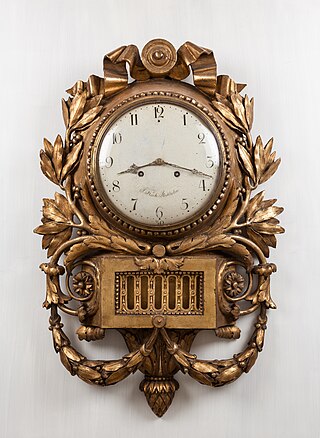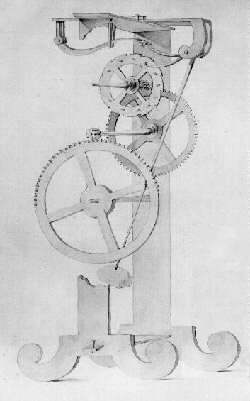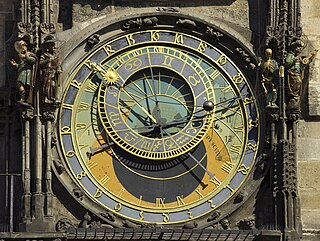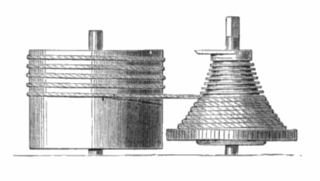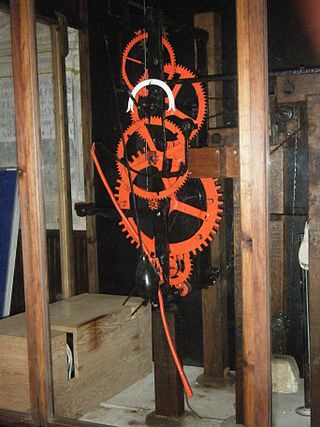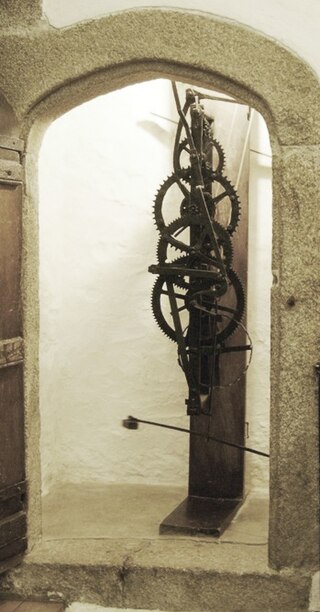| Year | Country | Place | Location | Name | Type | Mention | Comment |
|---|
| 1304 | Germany | Erfurt | Benedict abbey St. Peter | "Schelle" | not known | consecration of "Petronella" and "Scolastica" | probably a mechanical alarm clock |
| 1305 | Germany | Augsburg | cathedral | | not known | the "Domkustos" E. v. Nidlingen donates to the cathedral a "good and well adjusted clock" | probably a mechanical alarm clock |
| 1306 | England | Salisbury | Salisbury Cathedral | | not known | composition concluded 26 August 1306 "Before the clock of the cathedral had struck one no person was to purchase or cause to be purchased .... | probably a water clock |
| 1308 | France | Cambrai | Cathedral | | not known | mention of a clock, which was mended and equipped with moving figures in 1348, and fitted with a strike and an angel in 1398 | |
| 1309 | Italy | Milan | church St. Eustorgio | | not known | mention of a metal clock, which was repaired in 1333 and 1555 | |
| 1314 | France | Caen | church St. Pierre | | not known | mention of a striking clock | |
| 1316 | Poland | Brzeg | town hall | | not known | weights of the clock still present. New bell cast for clock 1370, replaced by new clock 1414 | |
| 1322 | England | Norwich | Norwich Cathedral priory | Norwich Cathedral astronomical clock | astronomical clock | Sacrist's roll of Norwich cathedral of 1322 to 1325 mentions the construction and installation of a clock which had a large astronomical dial and automata including 59 images and a choir or procession of monks | earliest detailed account of the organisation and of the craftsmen and materials involved in such a project |
| 1325–43 | France | Cluny | collegiate church | | not known | Petrus de Chastelux builds a new clock | |
| 1327 | England | St Albans | St Albans Cathedral | | astronomical clock | drawings | Earliest clock for which there is detailed description of the escapement, this had a 'strob' escapement, a variation of a verge and foliot with two escape wheels. |
| 1336 | Italy | Milan | town | | public striking clock with 24-hour dial | Annales Mediolanenses Anonymi | According to Bilfinger, this is the first mechanical striking clock and could have been made by de Dondi. This is the first time a clock is mentioned that strikes consecutive hours, e.g. once at 1, twice at two, etc. and that strikes day and night. As there are detailed descriptions of what the clock does, it was considered a novelty. Another candidate for the first mechanical clock. |
| 1348–64 | Italy | Padua | Castle Tower | Astrarium | astronomical clock with strike, verge and crown balance wheel | Il Tractatus Astarii | Giovanni de Dondi |
| 1351 | England | Windsor Castle | Great Tower | | | made in London by three Lombards (from Italy) who arrived 8/4/1352 and left on 24 May 1352 |
| 1351 | Italy | Orvieto | clock tower next to the cathedral | | striking clock with jacquemart | | |
| 1352–1354 | France | Strasbourg | cathedral | | astronomical clock. Three dials: bottom year dial with saint days, middle hour dial, top hourly procession of 3 kings before Maria, at the top a crowing rooster. | | taken out of service in 1547 |
| 1353 | Italy | Genoa | | | striking clock | | |
| 1354 | Italy | Florence | Palazzo Vecchio | | | | |
| 1355–71 | Italy | Reggio | | | striking clock | | |
| 1356 | Italy | Bologna | castle tower | | striking clock | | |
| 1356–1361 | Germany | Nuremberg | Frauenkirche | | striking clock with display of the prince-electors around the Kaiser | | substituted in 1508/09 with the clock on the outside of the Frauenkirche |
| 1359 | Germany | Frankenberg | Pfarrkirche | | astronomical clock with the three kings around the Virgin Mary | | |
| 1359 | Italy | Siena | city tower | | | Bartolo Giordi mounts a clock on the city tower | |
| 1361 | Germany | Frankfurt | cathedral | | astronomical clock | | made by Jacob, improved 1383, taken out of service 1605 |
| 1361 | Germany | Munich | city tower | | | mention of existing clock | |
| 1362 | Belgium | Brussels | St Nicholas church | | not known | mention of a turret clock | |
| 1362 | Italy | Ferrara | castle tower | | | clock mounted on castle tower | |
| 1362–1370 | France | Paris | Tour de l'Horloge | | verge and foliot striking clock | Froissart's poem "L'Horloge amoureuse" mentions the clock. Drawing exists. | a drawing of the going train shows a door frame construction. Built by the German Heinrich von Wiek. |
| 1364 | Germany | Augsburg | Perlachturm | | striking clock | | clock was repaired in 1369 and a quarter strike was added in 1526 |
| 1365–1367 | England | London | Westminster Palace | | not known | | a clock tower on the north wall at the end of the King's Garden opposite the entrance to the great hall was begun in 1365 and finished in 1367. |
| 1366 | Spain | Toledo | cathedral | | | goldsmith Gonzalo Perez supplies a clock for the tower of the cathedral | |
| 1366–1368 | Switzerland | Zurich | Petersturm | | striking clock | Master Chunrad von Cloten builds a striking clock for the Petersturm | |
| 1366 | England | Kent | Queenborough Castle | | striking clock | | |
| 1367 | Poland | Wrocław | town hall | | | mention of existing town hall clock | |
| 1368 | England | Kings Langley | Kings Langley Manor | | striking clock | Edward III provided a patent giving safe conduct to three Flemish clockmakers. These people probably built the clock. | after the expiry of the patent in 1369 John Lincoln was appointed as Royal clock keeper. |
| 1368 | Czechia | Opava | | | | Town council signs contract with master Swelbel to furnish a clock | |
| 1369 | Germany | Mainz | Pfarrkirche St. Quentin | | striking clock | | |
| 1370 | France | Colmar | cathedral tower | | striking clock | | |
| 1370 | Poland | Świdnica | | | | the town council engages the services of master Swelbel to furnish a clock, that is as good or better than the clock at Wroclaw. | |
| 1371 | England | York | York Minster | | striking clock | Fabric Rolls of York Minster record purchase of a new clock made by John Clareburgh in 1371 or £13 6s. 8d. | |
| 1372 | Belgium | Golzinne | castle | | striking clock | Louis Defiens furnishes a striking clock for the castle | |
| 1372–1373 | France | Strasbourg | cathedral | | striking clock | Heinrich Halder mounts a striking clock on the cathedral tower | |
| 1376 | Belgium | Ghent | Belfried | | striking clock | | |
| 1376 | France | Sens | | | | a clock with several bells is manufactured | |
| 1376 | France | Beauté-sur-Marne | castle | | | Pierre de S. Béate furnishes a clock for the castle | |
| 1377 | Belgium | Dendermonde | belfry | | | Jan van Delft manufactures a clock for the belfry | |
| 1377 | France | Valenciennes | town hall | | | the town hall clock is replaced and fitted with 2 striking figures | |
| 1377 | Italy | Vicenza | town hall | | striking clock | Master Facius Pisanus manufactures a new striking clock for the town hall | |
| 1377 | Belgium | Ypres | belfry | | striking clock with several bells | | |
| 1380 | Germany | Bamberg | cathedral | | | clock installed at the cathedral | |
| 1380 | France | Nieppe | castle | | | Pierre Daimville engaged to furnish a metal clock weighing 300 pounds for the castle, which already has an existing clock | |
| 1382–84 | Germany | Hamburg | Nikolaikirche | | striking clock | Blacksmith Schinkel furnishes a public striking clock for the Nikolaikirche | |
| 1383–1384 | France | Dijon | Notre-Dame | | striking clock | the clock taken from Courtrai in Belgium in 1382 is mounted on the tower of Notre-Dame | |
| 1383 | Germany | Fritzlar | | | | mention of a turret clock | |
| 1383 | France | Lyon | eglise St. Jean | | striking clock | mention of a small striking clock at St. Jean | |
| 1384 | Germany | Friedberg | | | striking clock | Wernher von Ilbenstedt manufactures a striking clock | |
| 1384 | Germany | Minden | cathedral | | | mention of the cathedral clock being repaired | |
| 1385 | Switzerland | Luzern | Graggenturm | | striking clock | Blacksmith H. Halder furnishes a striking clock for the Graggenturm and leaves a manual for the treatment of the clock | The operating instructions for this clock were written down, and clearly refer to a verge and foliot clock. the "frowen gemuete [happy/agitated mood]" is the foliot. [4] |
| 1386 | Germany | Braunschweig | Katharinenkirche | | | Marquard furnishes a clock for the Katharinenkirche. The cathedral already had a clock in 1346 | |
| 1386 | England | Salisbury | Salisbury Cathedral | Salisbury Cathedral clock | Striking Clock | Deed | might not be the clock on display at the cathedral |
| 1386 | Germany | Würzburg | cathedral | | | clock at the cathedral mentioned | |
| 1388 | France | Béthune | belfry | | striking clock | The citizens of Bethune want to re-construct the existing belfry and put up a clock. "... pour pouvoir reconstruire leur beffroi qui etait a present moult demolis et venus k ruyne et en peril de keir (tomber) de jour en jour et en obtenir l'autorisation d'y placer une orloge pour memore des heures de jour et de nuit sicomme il est en pluseurs autres lieux et bonnes villes du paus environ". | We have a reference here on how common turret clocks have become – they refer to " a clock to remind of the hours of the day and the night as it is now common in other places and good towns ...". This is also a reference that shows that turret clocks struck the time day and night. |
| 1388 | Germany | Magdeburg | Cathedral | | striking clock | mention of a striking clock at the cathedral | |
| 1389 | France | Rouen | belfry | | striking clock with quarter strike | Jehan de Felains paid 70 Livres for a clock with a quarter strike for the belfry | |
| 1391 | France | Metz | cathedral | | striking clock with quarter strike | Manufactured by Heinrich von Wieck | |
| 1392 | France | Chartres | | | striking clock | clockmaker and blacksmith Philibert Mauvoisin instructed to make a striking clock resembling the one at the Paris castle | |
| 1392 | Germany | Hanover | market church | | | blacksmiths Meistorpe and Hans Krieten furnish a clock for the market church | |
| 1392–1393 | England | Wells | Wells Cathedral | | striking clock | | if this is the clock now shown at the British Museum in London is questionable |
| 1394 | Germany | Stralsund | Nikolaikirche | | astronomical clock | Nikolaus Lilienfeld furnished a clock for the Nikolaikirche | |
| 1395 | Germany | Doberan | church | | astronomical clock | an astronomical clock similar to the one in Stralsund is put up at the church | |
| 1395 | Germany | Speyer | Altburgtor | | striking clock | a striking clock is reported at the Altburgtor and at the Predigerkirche | |
| 1398–1401 | Germany | Villingen | | | astronomical clock | Master Claus Gutsch manufactures an astronomical clock after the Strasbourg clock. | |



